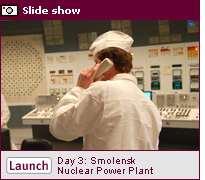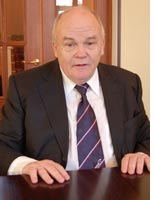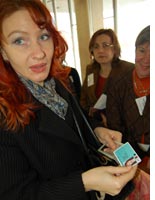A Nuclear Family Vacation in Russia
MOSCOW—"Oh no, you can't possibly do that," said Sergei Novikov with an indulgent smile. "It's prohibited by the laws of the Russian Federation."
Novikov, the top press official for Rosatom, Russia's national nuclear agency, was considering our request to visit a closed nuclear city. With his boyish looks, well-cut suit, and suave manners, he bore an odd resemblance to his counterparts in Washington. Perhaps D.C. junior achievers and ex- Komsomol types are distant cousins?
Either way, Novikov made it clear that our request was going nowhere. He recalled that a member of the Kremlin press pool—a wire-service reporter, he said, and a U.S. citizen—was prohibited from entering the nuclear city of Sarov, even during an official visit. (In fact, foreigners can get a permit to enter cities like Sarov, but under Russian President Vladimir Putin, journalists are routinely denied access.)
"So, you see," he continued with evident satisfaction, "it's quite impossible."
Rosatom, however, was willing to offer a consolation prize: Would one of us want to visit a Russian nuclear power plant?
Who could pass up that offer? Twenty years after the Chernobyl disaster put the brakes on the nuclear power industry, Russia is launching a drive to build 40 new reactors during the next two decades. The effort—which complements President Bush's Global Nuclear Energy Partnership—promises to have far-reaching consequences.
In Moscow, we met with Evgeny Velikhov, president of the Kurchatov Institute, Russia's premier nuclear-energy-research facility. He revealed the reasons for promoting nuclear power.
"If it weren't for Chernobyl, 100 percent of our electricity would be produced by nuclear power, and we would have the chance to export all of our natural gas," he told us. "Now we are moving in this direction again."
Freeing up natural gas for export does more than boost Russia's standing in the global economy. It also gives the Kremlin a powerful foreign-policy tool. As Russia's immediate neighbors—and Western Europeans—have learned, energy is a more effective guarantor of Russia's great-power status than its aging arsenal of nuclear weapons.
But promoting nuclear power requires a serious public-relations effort. In part, it means opening up Russia's secretive nuclear power industry to the press and selling wary consumers on the idea of nuclear safety.
In early April, Rosatom organized a press excursion to the Smolensk nuclear power plant. The timing was deliberate: In anticipation of the 20th anniversary of the Chernobyl disaster, Rosatom wanted to highlight the security and safety upgrades to Russian nuclear power plants. They invited the local and foreign press, including a busload of Bulgarian energy journalists. (Russia's nuclear-power-station construction company, Atomstroiexport, is bidding against a Czech consortium to build two nuclear power reactors in Bulgaria.)
It was no pleasure excursion. While the Smolensk facility is only 220 miles from Moscow, it took a bone-jarring seven-hour bus ride to get there. Minders from Rosatom thoughtfully loaded the bus with a crate of beer, a case of vodka, and some boxed lunches for the trip.
The Smolensk plant employs RBMK reactors. In other words, its three 1- gigawatt, graphite-moderated power blocks are the same basic design as Chernobyl Reactor 4, which exploded in 1986. Indeed, Desnogorsk—the company town built around the Smolensk power plant—still seems frozen in 1986. The city boasts a Soviet-era "palace of culture" but shows little evidence of the encroachment of Russian capitalism. An enormous Lenin mosaic adorns the front entrance to the power station.
After disembarking from the bus, we hustled through security turnstiles. In the men's changing room, a matron with blazing cranberry hair barked at us to strip down to our underpants. (Wearing the bunny suit—a white smock with matching shirt, pants, and chef's hat—is mandatory, as is a radiation-monitoring badge.)
On the tour, plant management was keen to show off the new technology and automated security controls that have been installed since 1986. The facility now boasts a faster emergency shutdown system, enhanced fireproofing and safety systems, and a redesign that is meant to limit and localize damage in the event of a catastrophic event. The plant also switched to a safer type of fuel.
More important, the Russians have changed the way personnel work and operate in the facility. Aleksandr Potapov, the deputy head of NIKIET, an energy research and development institute in Moscow, said the Chernobyl disaster prompted a "culture of safety" at Russian nuclear power plants.
"There was this overconfidence before Chernobyl," he said. "The reasoning went, we could put a man in space, we could harness the atom, and we didn't think this kind of disaster was possible. Chernobyl changed that."
Influencing public attitudes toward nuclear power in Russia is one thing, especially when the Kremlin sets the agenda on national television. But selling the rest of the world on Russian nuclear know-how is another matter.
The Russian government wants to turn nuclear energy into a top export. The Kurchatov Institute, for instance, is leading an effort to create affordable new reactor designs that would be ideal for growing power consumers like India. The institute is studying the concept of the "floating nuclear power plant"—essentially a nuke on a barge that would be operated by Russian specialists and plug into the local grid.
The Kurchatov Institute's Velikhov outlined the main advantages of this approach. Less-developed countries do not have power grids capable of absorbing a 1-gigawatt power station, he said, and Russia has decades of experience operating naval reactors. And more important, if a country agrees to buy a "floating" nuclear plant, it has no need for home-grown nuclear specialists.
"Just like you have with big passenger aircraft—Boeing or Airbus—you sign an agreement for full support," he said. "You are just leasing the plane."
That's an optimistic view, given one of Russia's major clients for nuclear power. The Iranians are building a nuclear reactor in Bushehr with Russian assistance, raising questions about who will control Iran's nuclear-fuel cycle. (A proposed U.S.-Indian nuclear deal has also complicated the issue.)
According to Rep. Curt Weldon, R-Pa., a longtime Russia-watcher and friend of Velikhov's, three years ago the Kurchatov Institute floated the idea of creating a joint entity with the United States to control nuclear fuel for Bushehr. But, he said, the United States missed the boat. (Weldon also famously believes that Able Danger, a classified military intelligence program, correctly identified several of the 9/11 hijackers prior to the event—a claim not supported by the commission that investigated those attacks.)
"Our government is so inept that we did nothing with it," Weldon said. "Today the headlines are, 'Russia announces nuclear plan with Iran.' Three years ago, we could have been part of the process."
Whatever the case, all sides seem to agree that nuclear energy could help foster U.S.-Russian cooperation and may represent a possible route to preventing proliferation among other countries. Or at least, that's the hope, a sentiment summarized in the corridor to the Smolensk control room, where visitors pass a massive Soviet-era sign reading, "THE ATOM WORKS FOR PEACE."


